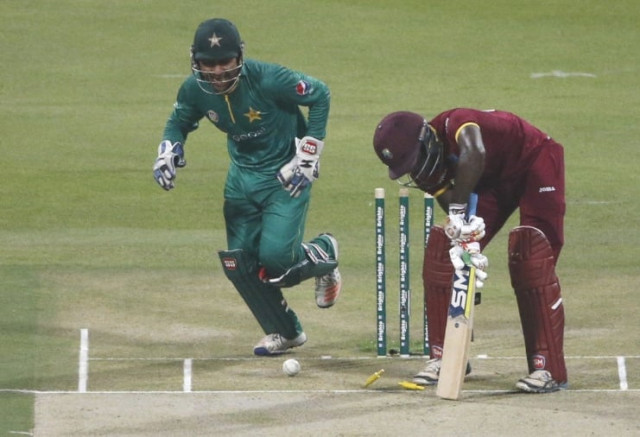The narrative of aggressive captaincy
Sarfraz's perfect 4-0 record highlights importance of leadership at domestic level

Pakistan T20I captain Sarfraz Ahmed (L) celebrates after wicket of Chadwick Walton (R) on September 27,2016.
PHOTO:AFP
Just about four weeks back, Pakistan limited over’s cricket looked horribly out of sorts, and no one really thought that the team will be able to win five consecutive limited-overs matches (one ODI and four T20Is) the way they did.
Pakistan whitewash West Indies
Four of those five victories, which were rather comprehensive, came under the leadership of Sarfraz, where the team looked as if they never had an issue. But lest we forget, it was pretty much the same team who had won just four out of their 11 T20Is before the 29-year-old took over the captaincy from Shahid Afridi.
It was obvious that fans and cricket experts saw the kind of spark in the wicketkeeper-batsman you need in the skipper to lead the team, which was evident as social media platforms were awash with fans exulting over the performance of the team and especially that of new captain Sarfraz, who had already been approved as the right man to lead the team in the shortest format by cricket enthusiasts.
 PHOTO: AFP
PHOTO: AFPTo be fair with Sarfraz, he truly made a remarkable beginning as skipper against the two World T20 finalists, where his team dominated the opposition throughout. Most of the delighted reactions from fans back home centred on the 29-year-old’s ‘aggressive captaincy’, which was praised all over the country.
Pakistan beat WI for T20 series win
But the real question is; do we even know what aggressive captaincy is, and do Pakistan really need an aggressive captain? In cricketing jargon, the term means the kind of leadership where the captain’s approach is picking up wickets in the field.
A prime example of this kind of captaincy reminds one of recently retired former New Zealand captain Brendon McCullum, who used to have slips more often than not throughout the match. However, that wasn’t the case with Sarfraz in any of his four matches as the captain, where he hardly had any slips.
Even when one recalls his captaincy during the inaugural edition of Pakistan Super League (PSL), the 29-year-old never had those close-in catchers to back the aggressive captaincy claim.
 PHOTO: REUTERS
PHOTO: REUTERSSo now the question arises: If Sarfraz was not aggressive, how was he so successful in all these four matches as well as in the past with Quetta Gladiators?
The answer is simple — in cricket, you don’t need to be an aggressive captain to be a successful one. The Karachi-born wicketkeeper is not an aggressive captain by the looks of it, and he admitted as much in his post-match talk that he never tried to over attack, and rather kept it simple, which means that what Pakistan fans need to understand is that aggression doesn’t guarantee success — knowledge of the game does.
The best examples of successful captains whose strategy was devoid of aggression includes the likes of New Zealand’s Stephen Fleming, India’s MS Dhoni and our own Misbahul Haq, who made great gains in their respective eras with sheer knowledge of the game, and will be remembered as the most successful skippers of their time.
A prime example of that was on show last night as well, where Sarfraz started with no close-in catchers, had long-on and deep mid-wicket or should I say cow corner for Imad Wasim’s first over of the day, and invited the batsmen to play across the line against a bowler who brings the ball back in at a good pace. The result was a wicket in Imad’s second over of the day which once again opened the floodgates of the Windies’ batting line up.
As Sarfraz’s accomplishment hints at a new and bright era for Pakistan cricket in the limited-over format, the demise of Azhar Ali’s captaincy in the ODIs should also be taken into consideration.
Azhar’s captaincy teaches a vital lesson that no one can become a captain overnight — it is a process that starts from a young age.
 PHOTO: REUTERS
PHOTO: REUTERSAzhar’s fault was lack of knowledge about the game, which is the basic requirement to ensure success. Perhaps if he had been groomed by the Pakistan Cricket Board (PCB) for some years before being appointed as the captain of the national side, things would have been different. But as luck would have it, he was thrown into a post-graduate exam before even getting done with schooling.
Sarfraz was rather clever all the way on September 7 against England, then again on September 24, 27 and 28 against West Indies, which made the opposition’s batsman look silly and yielded a result that was unexpected, especially after the kind of thrashing the same team received in the recently concluded ODI series against England.
He knew what he was doing on the field as he has already captained in domestic cricket and Pakistan U19 as well.
Terms such as ‘valiant’ or ‘aggressive’ might sound great to the ears, but have limited meanings in this game. It is practice that makes you perfect, and it is planning which makes you successful. One can be aggressive all they want, but in the end, the game is being played on the basis of skills and if one struggles to match that, defeat is unavoidable.



















COMMENTS
Comments are moderated and generally will be posted if they are on-topic and not abusive.
For more information, please see our Comments FAQ